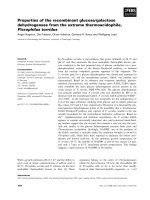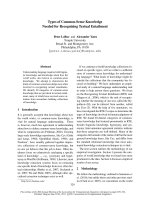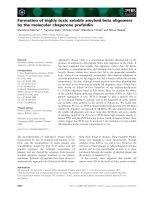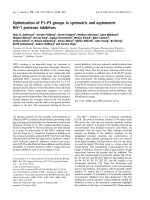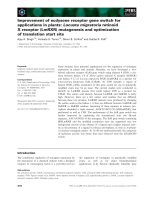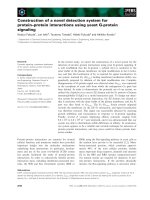Báo cáo khoa học: "Results of emergency Hartmann''''s operation for obstructive or perforated left-sided colorectal cancer" ppt
Bạn đang xem bản rút gọn của tài liệu. Xem và tải ngay bản đầy đủ của tài liệu tại đây (456.26 KB, 5 trang )
BioMed Central
Page 1 of 5
(page number not for citation purposes)
World Journal of Surgical Oncology
Open Access
Research
Results of emergency Hartmann's operation for obstructive or
perforated left-sided colorectal cancer
Pierre Charbonnet, Pascal Gervaz*, Axel Andres, Pascal Bucher,
Béatrice Konrad and Philippe Morel
Address: Department of Surgery, University Hospital Geneva, Switzerland
Email: Pierre Charbonnet - ; Pascal Gervaz* - ; Axel Andres - ;
Pascal Bucher - ; Béatrice Konrad - ; Philippe Morel -
* Corresponding author
Abstract
Background: Up to 15% of colorectal cancer (CRC) patients present with obstructive or
perforated tumours, and require emergency surgery. The Hartmann's procedure (HP) provides the
opportunity to achieve a potentially curative (R0) resection, while minimizing surgical trauma in
poor-risk patients. The aim of this study was to assess the surgical (operative mortality), and
oncological (long-term survival after curative resection) results of emergency HP for obstructive
or perforated left-sided CRC.
Methods: A retrospective review of 50 patients who underwent emergency HP for perforated/
obstructive CRC in our institution between 1995 and 2006.
Results: Median age of patients was 75 (range 22–95) years and the indications for HP were
obstruction (32) and perforation (18 patients). Operative mortality and morbidity were 8% and
26% respectively. 35 patients (70%) were operated with a curative intent; in this group, overall 1-,
3- and 5-year survival rates were 80%, 54% and 40%. In univariate analysis, the presence of lymph
node metastases was associated with poor 5-year survival (62% [Stage II] vs. 27% [Stage III], log-
rank test, p = 0.02). Eleven patients (22%) had their operation reversed with a median delay of 225
(range 94–390) days. In this subgroup, two patients died from distant metastases, but there were
no instances of loco-regional recurrence.
Conclusion: Hartmann's operation remains a good option to palliate symptoms in 30% of patients
with left-sided CRC who are not candidates to a curative resection. For those who have a curative
resection, the oncological outcome is acceptable, especially stage II patients, who appear to benefit
the most from this surgical strategy.
Background
Up to 15% of colorectal cancer (CRC) patients present
with obstructive or perforated tumors and require emer-
gency surgery. In this setting, colonic resections carry 10–
20% mortality and 30–50 morbidity rates, due to the
patients' poor condition [1,2]. Ideally, these patients
would benefit from preoperative insertion of a metallic
stent, in order to eventually perform a semi-elective cura-
tive resection with primary anastomosis [3]. Unfortu-
nately, most of these procedures are performed out of
Published: 23 August 2008
World Journal of Surgical Oncology 2008, 6:90 doi:10.1186/1477-7819-6-90
Received: 10 April 2008
Accepted: 23 August 2008
This article is available from: />© 2008 Charbonnet et al; licensee BioMed Central Ltd.
This is an Open Access article distributed under the terms of the Creative Commons Attribution License ( />),
which permits unrestricted use, distribution, and reproduction in any medium, provided the original work is properly cited.
World Journal of Surgical Oncology 2008, 6:90 />Page 2 of 5
(page number not for citation purposes)
hours, in elderly individuals, who are often dehydrated
and hemodynamically unstable, due to concomitant sep-
sis [4]: under these conditions, many experienced sur-
geons would consider prohibitive the risk to perform a
primary anastomosis. It is therefore not surprising that the
operation described by Henri Hartmann in 1921, consist-
ing of resection of the offending part of the left/sigmoid
colon, proximal end colostomy and closure of the rectal
stump, remains popular today, and has continued to extri-
cate surgeons and patients alike from many a delicate sit-
uation [5].
This procedure gained wide acceptance in the 1970s for
the management of complicated diverticulitis, and it is
surprising that few series have focused on CRC patients,
and addressed the oncological outcome of this procedure.
Back in the early 80s, surgeons from the Mayo Clinic
reported 54%, 23%, and 3% 5-year survival rates for Stage
II, III and IV cancers respectively, but a majority of
patients were electively operated [6]. Subsequently, Kris-
tiansen reported 5-year survival rate of 31% and that
intestinal continuity was restored in seven (24%) of 29
patients who underwent HP for obstructive left-sided CRC
[7]. In addition, McArdle and Hole have demonstrated
that emergency surgery for CRC is associated with high
(8%) mortality and poor (39%) 5-year overall survival
rates, even after a curative resection [8]. It would therefore
be tempting to consider that emergency HP for left-sided
CRC is an obsolete operation, often performed with a pal-
liative intent in elderly and/or very sick patients with a
high risk of cancer-related as well as intercurrent death [9].
Many surgeons, however, still consider that HP remains a
good option to achieve R0 resection, while minimizing
surgical trauma in poor-risk CRC patients [10,11]. The
aim of this study was to assess the surgical (operative mor-
tality), oncological (long-term survival after curative
resection) and functional (permanent colostomy vs. resto-
ration of intestinal continuity) results of emergency HP
for obstructive or perforated left-sided CRC.
Methods
This is a retrospective analysis of all patients who under-
went emergency Hartmann's procedure for CRC in our
institution between 1995 and 2006. The University Hos-
pital of Geneva is the only public medical institution in a
mainly urban area, and thus provides primary care for 75–
80% of a population of 500,000 inhabitants. An average
number of 350 colectomies are performed each year in
our institution, 90–95 being emergency resections. Ini-
tially, we considered all patients who were operated
within 48 hours of their unplanned admission for colonic
occlusion or colorectal perforation. Subsequently, we
selected in this population patients with a final diagnosis
of colorectal adenocarcinoma, as determined by his-
topathologic examination of the surgical specimen. The
charts of 50 consecutive patients with obstructive/perfo-
rated left-sided CRC who underwent emergency HP were
analyzed.
The following parameters were included in the structured
database:
1) Patients' demographics; gender; age; and ASA score,
2) Tumour characteristics; Location (left colon vs. rec-
tum); mode of presentation (obstructive vs. perforated);
TNM stage; and mode of dissemination for metastatic
cancers (peritoneal vs. liver).
3) Modalities of HP (first stage); type of resection (cura-
tive vs. palliative); degree of peritoneal contamination
(none vs. purulent vs. stercoral); operative mortality,
defined as death within 30 days of surgery; and postoper-
ative complications. The operative report was assessed to
determine with precision the reasons for not having per-
formed a primary anastomosis; those included preopera-
tive co-morbidities, peroperative hemodynamic
instability, localized/generalized peritonitis, and doubtful
viability of the proximal colon.
4) Modalities of HP reversal (second stage); delay
between HP and restoration of intestinal continuity; oper-
ative mortality; and surgical complications. We also
recorded the preoperative imaging and endoscopic inves-
tigations performed prior to reversal, such as CT scan,
colonoscopy, PET scan
Follow-up was carried out through routine visits at our
Outpatient Surgical Oncology Clinic, for those patients
who underwent adjuvant radiation or chemotherapy.
Serum CarcinoEmbryonary Antigen (CEA) levels were
assessed every three months during the first two years after
surgery and every six months thereafter. Yearly colonos-
copy and chest X-rays were performed routinely and
abdominal CT scan or liver ultrasonography were per-
formed in patients with raising CEA levels or clinical sus-
picion for tumour recurrence. Whenever possible,
confirmation of data was obtained through interviews
with the physicians or the patients. Primary outcome
measure was overall survival; secondary outcome meas-
ures were: 1) disease-free survival; 2) surgical mortality;
and 3) restoration of intestinal continuity (Hartmann's
reversal).
Statistical analysis
Life-tables curves (global survival endpoints: death, irre-
spective of course, and tumor-free survival endpoints: def-
inite tumor recurrence or death) were analyzed with the
Kaplan-Meier method and distributions were compared
World Journal of Surgical Oncology 2008, 6:90 />Page 3 of 5
(page number not for citation purposes)
by the log-rank test. In case of simultaneous analysis of
more than 2 populations, statistical differences were
assessed by an extension of Gehan's generalized Wilcoxon
test, Peto and Peto's generalized Wilcoxon test and the
log-rank test algorithms, using the Statistica 5.5. software
(Statsoft Inc, Tulsa, OK, US). Continuous data were ana-
lyzed by bilateral Student t test and dichotomous data
were analyzed by chi-square test. P values lower than 0.05
were considered significant.
Results
Median age of patients was 75 (range 22–95) years and
the indications for HP were obstruction (32) and perfora-
tion (18 patients). The median follow-up was 22 (range
5–111) months. All fifty patients were available for com-
plete follow up, except one who left our country. 29
patients died during this study period, and at the time of
last follow-up, 5 patients were alive with recurrence.
Operative mortality and morbidity were 8% and 26%
respectively. Patients' and tumours characteristics are
summarized in Table 1. Fifteen patients presented with
metastatic disease (12 = liver and 3 = carcinomatosis). For
the whole group, overall 1-, 3-, and 5-year survival rates
were 72%, 38% and 30% (Figure 1). 35 patients (70%)
were operated with a curative intent, with a median sur-
vival of 28 months; in this group, overall 1-, 3- and 5-year
survival rates were 80%, 54% and 40% (Figure 2). In uni-
variate analysis, the mode of presentation (perforation vs.
obstruction) was not associated with improved survival (p
= 0.51) (Figure 3). By, contrast, the presence of lymph
node metastases was associated with decreased 5-year sur-
vival (62% [Stage II] vs. 27% [Stage III], log-rank test, p =
0.02) (Figure 4).
Eleven patients (22% for the whole group, but 31% of
patients operated with a curative intent) had their opera-
tion reversed with a median delay of 225 (range 94–390)
days. There were no death and no anastomotic dehiscence
after the second stage of the procedure. However, two
patients had unsuccessful attempt to restore intestinal
continuity, one because of dense adhesions within the
pelvis, the other because of local recurrence, which was
undetected prior to surgery. In this subgroup, two patients
eventually died from distant metastases.
Table 1: Patients' and Tumour Characteristics (N = 50)
Parameter
Gender
Male 24
Female 26
Age, median (range) 75 (22–95)
Tumour location
Colon 35
Rectum 15
Tumour stage
II 13
III 21
IV 16
Adjuvant treatment
None 31
Radiation therapy 3
Chemotherapy 16
Restoration of intestinal continuity
No 39
Yes 11
Cause of death (N = 29)
Cancer 23 (local recurrence = 6)
Postoperative 4
Non cancer-related 2
Overall survivalFigure 1
Overall survival.
Survival according to type of resectionFigure 2
Survival according to type of resection.
World Journal of Surgical Oncology 2008, 6:90 />Page 4 of 5
(page number not for citation purposes)
Discussion
The data presented here indicate that 70% of patients who
underwent emergency surgery for obstructive/perforated
left-sided CRC had a curative resection. In this group, 5-
year survival rate was 40%. The prognosis was similar to
elective procedures, and strongly related to tumour stage,
more than to the mode of presentation. For stage II
patients, 5-year overall survival rate was 62%, and Hart-
mann's reversal rate was 63%. For those patients who pre-
sented with Stage IV disease, HP was effective in palliating
symptoms during a median survival of only 13 months.
In accordance with population-based study from Bur-
gundy [12], our data demonstrate that, in this difficult
clinical setting, resection for cure is still possible in 70%
of cases. By contrast, the operative mortality (8%) and
morbidity rates (26%) in this series compare favourably
with other, reporting mortality rates in the 10–15% range
for similar patients and conditions [13-15]. It has been
recognized, however, that the negative impact of emer-
gency surgery on CRC outcome is confined to the imme-
diate postoperative period [16]. Among Stage II-III CRC
patients surviving surgery, there is little difference in over-
all survival between patients undergoing emergency com-
pared with elective operation [17]. Thus, the goals of
surgery in poor-risk patients with obstructive or perfo-
rated CRC are two-fold; 1) providing effective palliation
of symptoms in patients with R1–R2 resections: and 2)
minimizing surgical mortality in patients with R0 resec-
tions.
As rightfully pointed out by Armbruster [18], primary
resection with anastomosis and HP are not competing
operations, but two situation-dependent therapeutic
alternatives. It should, however, be noted that the per-
formance of a resection with primary anastomosis exposes
the patients to the risk of anastomotic dehiscence; and
that a leaking colorectal anastomosis is associated with a
significant increase in local recurrence [19,20], as well as
poor long-term survival [21,22]. Therefore, efforts should
be made to avoid this complication and its consequences,
such as wound infection, intra-abdominal sepsis and the
need for subsequent re-operation, which inevitably delay
administration of postoperative chemotherapy in Stage III
patients, who would benefit the most from this adjuvant
modality [23].
It is known that a high percentage of CRC patients who
underwent HP end up with a permanent stoma. In our
series, eleven patients only (22% for the whole group;
31% of patients operated with a curative intent) had their
operation reversed with a median delay of 225 (range 94–
390) days. In two additional patients reversal was
attempted, but was considered unfeasible at the time of
surgery. Similarly low reversal rates have been reported by
other groups [24,25]. In our institution, Hartmann's
reversal in patients with CRC is usually delayed for 8–10
months, but not more: experience from the Dutch Rectal
cancer Trial has shown that if a stoma was not closed
within the first year, it would probably become perma-
nent [26]. The interval between the two stages of the pro-
cedures allows for identification of good risk patients for
stoma closure; patients with stage II tumours; patients
with stage III cancers who subsequently underwent adju-
vant chemotherapy; and socially active patients. By con-
trast, elderly patients with T4 or N2 tumours, who are at
high risk for developing local recurrence, are candidates
for a definitive colostomy.
Overall survival according to mode of presentationFigure 3
Overall survival according to mode of presentation.
Overall survival according to tumour stageFigure 4
Overall survival according to tumour stage.
Publish with BioMed Central and every
scientist can read your work free of charge
"BioMed Central will be the most significant development for
disseminating the results of biomedical research in our lifetime."
Sir Paul Nurse, Cancer Research UK
Your research papers will be:
available free of charge to the entire biomedical community
peer reviewed and published immediately upon acceptance
cited in PubMed and archived on PubMed Central
yours — you keep the copyright
Submit your manuscript here:
/>BioMedcentral
World Journal of Surgical Oncology 2008, 6:90 />Page 5 of 5
(page number not for citation purposes)
Conclusion
Hartmann's operation is effective in palliating symptoms
in 30% of patients with obstructive/perforated stage IV
left-sided CRC. For those who are candidates to a curative
resection, this approach minimizes surgical mortality/
morbidity and is associated with stage-dependent survival
rates close to those of elective operations. Patients with
stage II cancers have good oncological (62% 5-year sur-
vival rate) and functional (63% reversal rate) outcomes,
and benefit the most from this surgical strategy. Some
experts consider that the Hartmann's procedure is today
"out of vogue"; it might be true for complicated diverticu-
litis, but probably not for the emergency management of
left-sided colorectal cancer-the original indication for this
time-honoured operation.
Competing interests
The authors declare that they have no competing interests.
Authors' contributions
PC and PG conceived of the study and wrote the manu-
script. AA performed the statistical analysis. FG and BK
coordinated the study and helped to draft the manuscript.
PM supervised the study. All authors read and approved
the final manuscript.
References
1. The Association of Coloproctology of Great Britain and Ire-
land. Guidelines for the management of colorectal cancer
2001:32 [
].
2. Finan PJ, Cambell S, Verma R, MacFie J, Gatt M, Parker MC, Bhardwaj
R, Hall NR: The management of malignant large bowel
obstruction: ACPGBI position statement. Colorectal Dis 2007,
9(suppl 4):1-17.
3. Breitenstein S, Rickenbacher A, Berdajs D, Puhan M, Clavien PA,
Demartines N: Systematic evaluation of surgical strategies for
acute malignant left-sided colonic obstruction. Br J Surg 2007,
94:1451-1460.
4. Tekkis PP, Kinsman R, Thompson MR, Stamatakis JD: The Associa-
tion of Coloproctology of Great Britain and Ireland study of
large bowel obstruction caused by colorectal cancer. Ann Surg
2004, 240:76-81.
5. Hartmann H: Note sur un procédé nouveau d'extirpation des
cancers de la partie terminale du côlon. Bull Mem Soc Chir Paris
1923, 49:1474-1477.
6. ReMine SG, Dozois RR: Hartmann's procedure. Its use with
complicated carcinomas of sigmoid colon and rectum. Arch
Surg 1981, 116:630-3.
7. Kristiansen VB, Lausen IM, Frederiksen HJ, Kjaergaard J: Hart-
mann's procedure in the treatment of acute obstructive left-
sided colonic cancer. Ugeskr Laeger 1993, 155:3816-3818.
8. McArdle CS, Hole DJ: Emergency presentation of colorectal
cancer is associated with poor 5-year survival. Br J Surg 2004,
91:605-609.
9. Meyer F, Marusch F, Koch A, Meyer L, Fuhrer S, Köckerling F, Lippert
H, Gastinger I, the German Study Group "Colorectal Carcinoma (Pri-
mary Tumor)": Emergency operation in carcinomas of the left
colon: value of Hartmann's procedure. Tech Coloproctol 2004,
8:S226-229.
10. Duran GRH, Abril VC, Herreros RJ, Concejo CP, Paseiro CG,
Sabater MC, Jadraque JP, Duran SH: Hartmann's procedure for
obstructive carcinoma of the left colon and rectum: a com-
parative study with one-stage surgery. Clin Transl Oncol 2005,
7:306-313.
11. Dee WS, Salleh I, Khoon HT: Hartmann procedure: is it still rel-
evant today? ANZ J Surg 2005, 75:436-440.
12. Cheynel N, Cortet M, Lepage C, Benoit L, Faivre J, Bouvier AM:
Trends in frequency and management of obstructing color-
ectal cancers in a well-defined population. Dis Colon Rectum
2007, 50:1568-1575.
13. Mandava N, Kumar S, Pizzi WF, Aprile IJ: Perforated colorectal
carcinomas. Am J Surg 1996, 172:236-238.
14. Bielecki K, Kaminski P, Klukowski M: Large bowel perforation:
morbidity and mortality. Tech Coloproctol 2002, 6:177-182.
15. Deen KL, Madoff RD, Goldberg SM, Rothenberger DA: Surgical
management of left colon obstruction: the University of Min-
nesota experience. J Am Coll Surg 1998, 187:573-576.
16. Coco C, Verbo A, Manno A, Mattana C, Covino M, Pedretti G, Petito
L, Rizzo G, Picciocchi A: Impact of emergency surgery in the
outcome of rectal and left colon carcinoma. World J Surg 2005,
29:1458-1464.
17. Smothers L, Hynan L, Fleming J, Turnage R, Simmang C, Anthony T:
Emergency surgery for colon carcinoma. Dis Colon Rectum
2003, 46:24-30.
18. Armbruster C, Kriwanek S, Roka R: Spontaneous perforation of
the large intestine. Resection with primary anastomosis or
staged (Hartmann) procedure? Chirurg 2001, 72:910-913.
19. Branagan G, Finnis D, Wessex Colorectal Cancer Audit Working
Group: Prognosis after anastomotic leakage in colorectal sur-
gery. Dis Colon Rectum 2005, 48:1021-1026.
20. Merkel S, Wang WY, Schmidt O, Dworak O, Wittekind C, Hohen-
berger W, Hermanek P: Locoregional recurrence in patients
with anastomotic leakage after anterior resection for rectal
carcinoma. Colorectal Dis 2001, 3:154-160.
21. Bell SW, Walker KG, Rickard MJ, Sinclair G, Dent OF, Chapuis PH,
Bokey EL: Anastomotic leakage after curative anterior resec-
tion results in a higher prevalence of local recurrence. Br J
Surg 2003, 90:1261-1266.
22. Walker KG, Bell SW, Rickard MJ, Mehanna D, Dent OF, Chapuis PH,
Bokey El: Anastomotic leakage is predictive of diminished sur-
vival after potentially curative resection for colorectal can-
cer. Ann Surg 2004, 240:255-259.
23. Jessup JM, Stewart A, Greene FL, Minsky BD: Adjuvant chemo-
therapy for stage III colon cancer: implications of race/eth-
nicity, age, and differentiation. JAMA 2005, 294:2703-2711.
24. Roque-Castellano C, Marchena-Gomez J, Hemmersbach-Miller M,
Acosta-Merida A, Rodriguez-Mendez A, Fariña-Castro R, Hernandez-
Romero J: Analysis of the factors related to the decision of
restoring intestinal continuity after Hartmann's procedure.
Int J Colorectal Dis 2007, 22:1091-1096.
25. Banerjee S, Leather AJ, Rennie JA, Samano M, Gonzalez JG, Papagrigo-
riadis S: Feasibility and morbidity of reversal of Hartmann's.
Colorectal Dis 2005, 7:454-459.
26. den Dulk M, Smit M, Peeters KC, Kranenbarg EM, Rutten HJ, Wiggers
T, Putter H, Velde CJ van de, Dutch Colorectal Cancer Group: A
multivariate analysis of limiting factors for stoma reversal in
patients with rectal cancer entered into the total mesorectal
excision (TME) trial: a retrospective study. Lancet Oncol 2007,
8:297-303.


